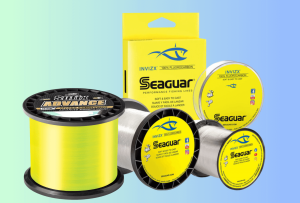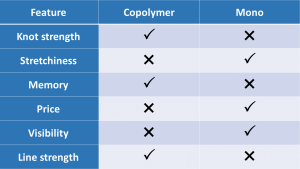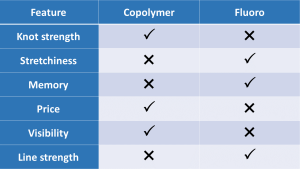Nowadays, the demand for fishing is greater, and improving fishing lines is necessary to improve the fishing experience. And one of those improvements, the copolymer fishing line, has received much attention from anglers. This type of fishing line is known for its abrasion resistance and high durability, but its price is second only to fluorocarbon. Many people also ask the question: Does copolymer fishing line float? And to know this, scroll down for more details.
Contents
What is copolymer fishing line?
We commonly know three main kinds of fishing line material today: braid, monofilament, and fluorocarbon. Each of them has different features and usages. With the braid line, it is the earliest version that has been around for 100 years. When fishing, the braid line offers all characteristics that come in handy: excellent strength, knot strength, and minimal stretch.
The monofilament line, a plastic polymer, improves the braid function, making it seem invisible in water; the line is more difficult for fish to see if it is available. However, the monofilament may stretch before breaking.
We call fluorocarbon the most cutting-edge line among three kinds of fishing lines, which is created by polyvinylidene fluoride. The fluorocarbon line is a polymer that can be invisible in water because of its identical refractive index. But the price for having a fluorocarbon line is the highest.
So, the product of the copolymer fishing line hopes to solve this problem and bring a wonderful experience for anglers.
The copolymer fishing line is created by mixing two types of line. The primary polymer will be similar to inexpensive monofilament, while the second will improve strength and knot and have lower visibility.
What are the pros & cons of copolymer fishing line?
Comparing the pros & cons of each fishing line will help you make a good decision, find out what you need to buy for your demands, and avoid unnecessary hesitation.
Pros: One of the most critical aspects of the copolymer line is its invisibility in water. This line is more invisible than the braid or monofilament line. Compared to the monofilament line, the more copolymer has a thinner diameter, the more copolymer can bring excellent tensile strength. Also, the copolymer has a higher abrasion resistance than the monofilament. Compared to fluorocarbon, the copolymer has a superior knot strength in some conditions.
Cons: The copolymer is not as inexpensive as the mono because of the high cost of materials. Also, the copolymer is not as invisible, abrasion-resistant, and strong as the fluorocarbon.

What is the difference between copolymer and monofilament fishing line?
While the copolymer fishing line is the evident choice that you stack the two against one another, the monofilament line has been a time-tested alternative that many anglers rely on. Although the copolymer is more expensive than the spool, just a few bucks, it is worth extra for anglers to extra a few dollars.
The most common reason is that the copolymer has superior abrasion resistance and low visibility compared to the mono. Also, the tensile strength is significantly improved relative to the diameter of the fishing line. The above characteristics prove that the copolymer outperforms the monofilament in every measure.
Therefore, if choosing whether to buy a copolymer or monofilament line, the copolymer will be the better choice in any situation.

What is the difference between copolymer and fluorocarbon fishing line?
If it is said that a fishing line made from copolymer can beat the fluorocarbon fishing line in terms of function, the answer is no. In fact, fluorocarbon fishing line is the type with the best stealth when in water compared to the other types. In addition, it cannot be denied that the resistance and strength of the fluorocarbon fishing line are excellent. However, price is one of the limitations of fluorocarbon fishing lines, which is explained by the high cost of manufacturing this type of fishing line.
Copolymer fishing line is less expensive than fluorocarbon, so it will be less effective in terms of use. However, if you want to cinch your knots, a copolymer fishing line will be easier than fluorocarbon fishing line because fluorocarbon is stiffer and lacks stress.
Therefore, If you don’t care about money, fluorocarbon fishing line will be an excellent choice. But using a copolymer fishing line is also safer if you have budget constraints.

Does copolymer fishing line float?
It depends on the original materials used to build its construction because some kinds are designed to sink while others are created to float. They understand that what type of fishing line best suits your needs can make all the difference in your success on the water!
Typically, the copolymer line made from polyethylene and polyvinyl chloride (PVC) will float onto the water. Taking advantage of floating this material will help your line more effortlessly and keep your bait at the surface.
The combination of nylon and PVC will create the sinking fishing line. The purpose of a sinking line is to feel whether the bait is plunging into a lake and ocean or not. It will make it more difficult for predators to spot your bait sinking deeper into the water column.
What type of fishing line does not float?
The monofilament fishing line is notoriously unsinkable by most anglers. The main component that contributes to this property is the diameter of its substance. The fishing line will fall if the material is too thick, and vice versa. So, the copolymer, a mixture of monofilament and fluorocarbon, will counter this problem. Another way is buying extra support materials, such as Vaseline, which will be inexpensive.
Conclusion
In short, to answer the question, does the copolymer fishing line float? Then, you need to determine your needs and what type of fishing line you want to float or sink. A copolymer fishing line will be able to float or sink, depending on what the original material is. If you find this post helpful, please follow us to see other articles in the future.


